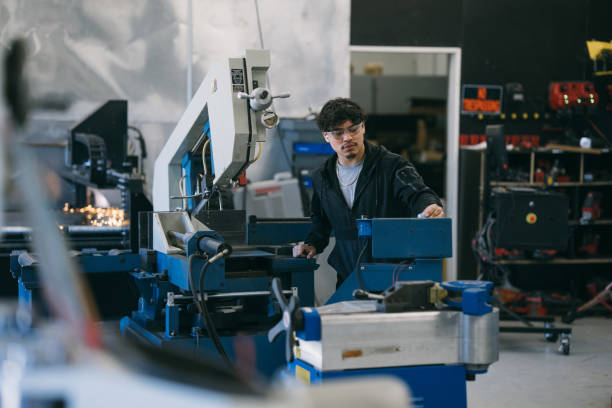Manufacturing has entered a phase where precision is no longer optional—it’s fundamental. As components become ever more complex, tolerances tighten, and parts are pushed to the limits of what machines can do, manufacturers are looking for ways not just to build, but to build accurately, repeatably, and efficiently. One of the axis on which all of this pivots is measurement — metrology — and its integration into automated systems.

Why Measurement Matters More Than Ever
A CNC machine might move along a toolpath with absolute fidelity to its program, but the reality is that small variations creep in: tool wear, thermal drift, misalignment, vibration. Over a production run, these accumulate, potentially pushing parts outside tolerance. Traditional measurement after the fact (on CMMs or by hand) helps catch errors, but often too late — the opportunity to correct or prevent defects has passed.
Enter metrology woven into the manufacturing flow. When measurement becomes part of the process rather than an afterthought, you gain:
- Early detection of deviations: Subtle misalignments or drift can be caught before scrap is produced.
- Reduced uncertainty: If you know your machine geometry, probe calibration, and part alignment are consistent, then the rest of your process has a firmer foundation.
- Better resource use: fewer cycles of rework, fewer scrapped parts, less wasted time.
What Automation Brings to Measurement
Putting measurement tools on their own (CMMs, probes, scanners) helps, but having them built into the manufacturing workflow adds qualitative leaps. Some of the key capabilities are:
- Real-time calibration and probe setup
In many CNC systems the probe—or touch-probe, optical probe, whatever form factor—is assumed to be correct once installed. But if its calibration or alignment shifts even slightly, every measurement after that is suspect. Automated probe calibration minimizes human error and ensures that measurement starts off from a known baseline. - Automated machine performance checks
Instead of periodically stopping production for manual checks (which risk introducing error and consume downtime), automated checks embedded in the workflow monitor the CNC machine’s health. Are axes aligned correctly? Is torque or backlash creeping in? Such checks can allow corrective maintenance or adjustment before out-of-tolerance parts appear. - Part alignment within the machine
Even with a perfect tool, if the part isn’t located exactly as the model assumes, dimension errors result. Automated part locating solutions measure where the part actually is (in X, Y, Z, plus any rotation) and adjust toolpaths or coordinate systems accordingly. This is especially important with multi‐axis machining, where small misplacements get magnified. - “Lights-out” machining
With machine checking, probe calibration, and part alignment integrated and automated, it becomes possible to run machining operations unattended (or with minimal supervision). This opens up schedules outside standard shifts, better utilisation of capital equipment, and potentially lower operating costs in the long run. - Data and feedback loops
Collecting metrology data (probe calibration stats, alignment data, machine geometry trends) gives you visibility over variation, drift, and performance over time. That in turn enables predictive maintenance, process improvement, and better decision-making.
Challenges & What It Takes to Make It Work
Bringing measurement automation into a manufacturing setting isn’t trivial. Some of the main obstacles include:
- Integration complexity: It’s not just about buying a probe and plugging it in. Calibration, communication with the CNC controller, software–hardware compatibility, and ensuring that each component works with tight tolerances are all nontrivial engineering tasks.
- Reliability and consistency: Automated tools must maintain accuracy over time, under varying environmental conditions (temperature shifts, vibration), tool wear, etc. Without consistency, measurement becomes noise.
- Skill and training: Even if many manual steps are removed, the system depends on correct setup, monitoring, calibration, and interpretation of measurement data. Staff must understand what the measurement data really means and when to act on it.
- Initial investment: Often the upfront cost—both for hardware, software, and for restructuring workflows—can be significant. The return comes through reduced scrap, higher yield, shorter lead times, but planning is required.
- Managing data: There’s a lot of measurement data. Deciding which data to retain, how to analyse, and how to act on trends (rather than reacting to individual defects) is essential.
Where the Field Is Heading
Several trends suggest more of this measurement-embedded automation:
- Tighter tolerances, more complex geometry: As industries like aerospace, medical, energy demand more from parts (lighter, stronger, more complex), the margin for error shrinks. That demands more reliable, automated measurement.
- Digital twins and simulation: Virtual models of both the machine and part, including error sources, allow predictive correction. If you can simulate how a tool deflection or thermal drift affects a part, you can compensate in advance.
- Connected manufacturing / Industry 4.0: Measurement systems that feed data in real time to higher-level analytics, machine learning systems. This connects shop-floor variation to maintenance, process tuning, and possibly even design feedback.
- Increased autonomy: From automating single steps to more and more of the production workflow becoming self-adjusting. Probe calibration, machine checks, alignment, tool wear compensation all become part of a continuous “self-checking” system.
Conclusion
The real power of automated manufacturing technology lies not in faster cutting or bigger machines, but in bringing measurement in close to the process to keep errors small, detect drift early, and ensure consistency. For manufacturers serious about quality, yield, and precision, it’s no longer enough to assume setups are perfect or that manual checks will suffice. Automation in measurement — metrology embedded in the workflow — is quietly becoming one of the defining elements of what it means to manufacture well.

